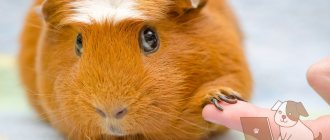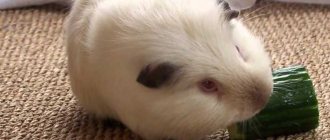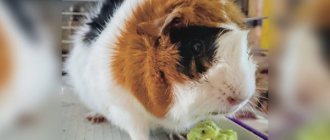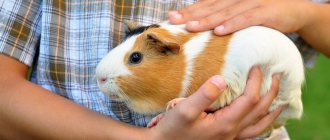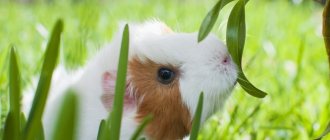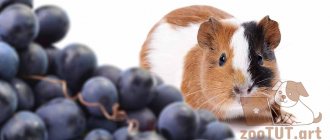In order for your guinea pig to live as long as possible, you need to monitor the quality of its diet. Unfortunately, sad statistics say that most often pigs die due to problems with the gastrointestinal tract. Therefore, it is necessary to think through her nutrition carefully.
Your pet should eat a balanced diet and regularly. If a rodent is not fed for at least a day or more, it will die of starvation. Exhaustion begins immediately. Therefore, you should never skip meals. The pig should be fed the foods it would eat in the wild. Many owners, having this cute animal at home, do not know how and what to feed the rodent properly.
The ancestors of guinea pigs ate simple food in the wild - they ate grass, tree bark, and various fruits that they found under fruit-bearing trees. The domesticated guinea pig is not far from its predecessors - it needs food.
A pig's intestines are extremely long in size, and the walls of its stomach are incredibly thin. To normalize digestion, they need to constantly chew and digest something. Rodents also grow teeth throughout their lives, so they need to eat solid foods to wear down their teeth.
Can guinea pigs eat apples and pears?
In the branches, the animal will not only find the substances necessary for health, but with the help of them it will be able to massage the gums, which itch due to the constant growth of teeth.
But can all the branches be consumed by the pig, or are there restrictions?
What do guinea pigs eat and what can cause them to die?
Guinea pigs are very popular pets. Good-natured, smart, cute and quite unpretentious, they are popular with adults and children.
Of course, in order for them to live a long time and all this time to delight their owners with excellent health and playfulness, it is necessary to properly organize the nutrition of guinea pigs.
After all, this is the key to their health, so it will be useful to talk about the diet in more detail.
What to feed your favorite rodent
Organizing food for guinea pigs at home is much more difficult than it might seem at first glance. It must be balanced and contain all the necessary substances.
In nature, rodents take care of themselves and usually easily find exactly the food they need. But in a cage, their diet is very limited, so the owner must take on these responsibilities.
Try to ensure that the choice is large enough so that your pet can easily find products containing the vitamins he needs.
Nuts
Nuts are a great addition to your pet's diet. But not all guinea pigs like them - it depends on the taste preferences of a particular individual. However, it is worth remembering that they contain a large amount of proteins and vegetable fats. Therefore, even if your pet literally loves to eat nuts, you should not give more than a few grains a week.
You cannot make nuts the main food crop - a guinea pig, living in a cage and moving little, will quickly develop obesity and a bunch of associated diseases.
The following nuts can be given:
- hazelnut,
- walnuts,
- almond,
- cashew nuts,
- cedar.
Of course, under no circumstances should you give fried foods, or nuts with salt or any flavorings. They are of no use to humans, and they will definitely harm a small rodent.
Healthy Supplements
When talking about proper nutrition for guinea pigs, one cannot fail to mention hay. Make sure it is always in a cage. Thick, hard stems are desirable.
On the one hand, it contains useful substances that the rodent may not receive from the main food. But what’s even more important is that your pet will wear down its incisors on the rough straw. Rodents' teeth grow throughout their lives.
In the most advanced cases, they become so long that the animal cannot eat normally.
If you have the opportunity, it is best to store hay yourself - away from cities, in the forest. An excellent choice would be herbs such as:
- plantain,
- clover,
- dandelion,
- nettle,
- chamomile,
- Highlander,
- sweet clover,
- tansy,
- blooming Sally.
In addition to straw, there should always be a mineral salt stone in the cage. It allows the guinea pig not only to grind down its teeth, but also to compensate for the lack of salts - there are clearly not enough of them in plant foods. The easiest way to buy it is at any pet store - it is relatively inexpensive.
Purchased food
Some guinea pig owners, not wanting to rack their brains over a balanced diet, prefer to buy ready-made formulas. In theory, they are good because they contain all the necessary minerals and vitamins.
Alas, in practice it does not always work out this way. Often the package simply contains seeds and cereals that contain practically no vitamins. You can feed guinea pigs with such mixtures, but not for months, or regularly enrich the diet with additional food.
How to give pumpkin correctly
The food we feed our favorite animals directly affects their well-being and appearance. Most often, when the owner wants to pamper his pet and treat him to “something tasty,” such delicacies are strictly contraindicated for hamsters.
It is allowed to carefully give your pet a taste of this or that vegetable in small portions and observe the reaction. However, hamsters are quite capable of digesting the pulp of fresh pumpkin.
For variety, furry rodents can periodically include raw or processed pumpkin in their diet. One option is to give hamsters stewed, steamed or boiled pumpkin.
The first step is to wash the product well. Then serve it like this or heat treat it. When you bring a purchased pumpkin from the store, you should definitely wash it well, and it is best to remove the peel in a very thick layer.
It is necessary to cut the peeled flesh into small pieces to make it easier and more convenient for the hamster to eat them. Also, it is important to promptly remove uneaten leftovers from the cage, otherwise they will begin to rot, and the animals should eat only fresh food.
Canned vegetables are never suitable for feeding your furry friend!
The best quality vegetable is always the one that was grown in its own garden, without treatment with pesticides.
Vitamins and minerals
The fact is that the body of guinea pigs does not contain a special enzyme, I-gluconolactone oxidase, which is involved in the synthesis of vitamin C from glucose. It is because of this circumstance that your pet is not able to get this incredibly valuable vitamin from regular food. Your task throughout the animal’s life is to regularly provide it with ascorbic acid.
With a lack of vitamin C in the body of an adult, the following pathologies can occur (most often manifested as symptoms of scurvy):
- retardation of movements, visual lameness (although the animal did not fall), decreased activity;
- lack of appetite, external lethargy and indifference to what is happening;
- diarrhea, swelling of joints;
- there is blood under the skin and in the secretions;
- bleeding and falling out teeth;
- the animal looks disheveled, the fur is crumpled, and may even fall out.
In summer, the diet should be replenished with plenty of fresh greens, plants, leaves and stems, not to mention fresh vegetables and fruits. Most of these fruits contain ascorbic acid. As for the cold winter period, it is necessary to gradually add synthetic ascorbic acid to the diet. Pregnant females, older individuals and young animals need an increased dose of vitamins, as well as an increased amount of food.
For an adult, you need at least 15 mg of vitamin C per kilogram of weight daily; for pregnant women and young animals, approximately 40-45 mg per kilogram of weight should also be given every day.
The greatest amount of vitamin C is found in the following vegetables, plants and fruits: tomatoes, broccoli, apples, nettles, burdock, as well as raspberry and currant branches (always with leaves), dandelion, basil, mint, parsley, cabbage, kiwi. Remember that many of these plants should be given in strictly limited quantities.
Almost all of the listed vegetables and fruits can be found in the public domain in the summer and autumn, which is why preference should be given to these products in the summer rather than synthetic vitamins.
Be careful when choosing a place to collect all the necessary herbs (in case you do not trust herbs from pet stores). Try to choose areas far from factories, roads and industrial enterprises to collect them. The greatest danger is in grass collected from parks and city lawns. Typically, such plants are treated with harmful chemicals against parasites, which will also negatively affect your pet.
There are only two problems with such capsules:
- you will not recognize their composition in any way due to the fact that the mixture is homogeneous; it is impossible to determine the composition, as well as to detect the presence of sawdust and dust, which sellers love to add to capsules;
- capsules are intended for long-term use, they can be stored for a long time in one specific place, and ascorbic acid, after 3 months from the date of production, begins to gradually deteriorate and loses its beneficial properties.
When purchasing ready-made feed mixtures, you should always check the production date. To ensure that the food is fresh and does not spoil, it should be stored in a dry, dark place with low humidity. It is under such conditions that ascorbic acid will slow down the decomposition processes.
Is it possible to give pumpkin seeds to a hamster?
Pumpkin seeds are considered a healthy product. They are added to ready-made grain mixtures for hamsters. If you choose your own menu for your pet, don’t forget to add these seeds. Your little animal will undoubtedly not mind eating them.
Pumpkin seeds in a hamster's diet will help get rid of helminths - the substance contained - cucurbitin - has an anthelmintic effect. Protein, fat, vitamins A, E, B, phosphorus, zinc, potassium and magnesium - all this is part of pumpkin seeds.
It is worth remembering that seeds for hamsters should be raw, peeled, without salt and spices.
The benefits of pumpkin in the diet of small rodents are obvious. You can include the product in your pet’s menu, but you still don’t need to give it constantly. With variety in the diet, the hamster will receive the necessary vitamins and will enjoy eating it with pleasure.
Possible problems
Animals, like people, can suffer from overeating. The stomach is not always able to process excess amounts of food, which negatively affects the pet’s condition. And excessive consumption of sweets does not have the best effect on health.
Do not forget that the Product given to the rodent must be of high quality. This will protect your pet from poisoning and diarrhea. In addition, banana is considered an astringent product.
An excessive amount of such treats will not allow the animal to go to the toilet in a timely manner. And irregular bowel movements and retained excrement in the body have a negative impact.
Overeating and poor-quality products harm the animal
It is important to remember that it is important to approach your pet’s nutrition as responsibly as you do your own.
Simple wire cutters
The most primitive device is very similar to ordinary scissors. Only one of its cutting surfaces is equipped with a small notch with a sharp edge. Using such a device is easy, provided you have some skill and experience. For young dogs, nail trimming is always stressful. They do not want to sit quietly, they strive to tear the paw out of the owner’s hands and in every possible way complicate the process. So Litbro.ru will not recommend such a gadget to novice dog breeders. The risk of causing serious physical injury to your pet is too great. Well, for experienced owners who have used similar tools more than once, nothing better can be desired. Cheap and very effective.
Cost – 35 – 72 rubles.
More advanced versions of hand cutters offer expanded functionality.
Although their main part, in the old fashioned way, is based on two cutting surfaces. Service additions imply only human convenience. Models with rounded ends, a container for cut claws and lighting have proven themselves very well. The fact is that some dogs have the habit of looking for clipped ends on the floor and eating them. Sharp, bent cuttings can damage the stomach wall and cause bleeding. A small “waste collection” effectively solves this problem.
Price – 636 rub.
Another gadget from the line of simple nippers has comfortable ergonomic handles that allow you to securely hold the tool while trimming nails.
This is important when the animal gets nervous and breaks out.
We pay attention to one more detail - the expansion spring. It fixes the cutting surfaces in the open state, which makes the operation somewhat easier.
Otherwise, the functions of the device duplicate all the features of its predecessors. To properly shorten claws, you must have the skill and achieve unquestioning obedience from your dog or cat.
Cost – 229.93 rubles.
What you need to know
Pears contain a large amount of easily digestible sugar, and sweets are harmful to the guinea pig’s body, so you should not include them in the daily menu.
Bloating, indigestion - such troubles can await a gourmand. And if this fruit is given in combination with water, it can cause diarrhea.
Juicy food, including pear, is introduced into the diet of animals in autumn and winter, when there is practically no green food. It should be borne in mind that vegetables and fruits should make up 1/5 of the daily menu.
You can give from two to four types of vegetables and fruits per day.
Any new food for pigs is given gradually, in small portions.
The pig will express its taste preferences for a particular product by leaving it uneaten during the day. Then the delivery of such a “dish” can either be reduced or stopped altogether.
Some sources say that it is permissible to feed guinea pigs leaves and young pear twigs.
It is strictly forbidden to bear fruit:
- polluted,
- unripe,
- overripe,
- moldy,
- rotten.
Almost all breeds of guinea pigs need the same diet. As for eating pears, there is always a caveat: infrequently and a little.
Considering all of the above, it is logical to come to the conclusion: the wisest thing is to carefully monitor the tastes and behavior of your pet, they are all individual. If “too much fruit” causes diarrhea in most animals, some, on the contrary, will suffer from constipation, while others will eat it with pleasure without any health consequences.
Fruits and berries
Bananas
Can guinea pigs have bananas? A banana rich in potassium will benefit your guinea pig, but you should not give more than 1 piece per day.
The peel of the vegetable must be removed, as it is treated with substances hazardous to health (wax, chemicals, ethylene and pesticides). For safety, it is better to remove soft fibers from the fruit.
Can guinea pigs eat a pear?
Pears can be given with the peel, but without the seeds. The fruit is washed well and cut into pieces; the pig should be offered water along with it. Excessive consumption of pears due to their high sugar content can cause diarrhea.
Can guinea pigs eat kiwi?
Kiwi is a very healthy fruit for animals. It contains a large amount of ascorbic and folic acids. It is also rich in vitamins E, iron, calcium, magnesium and phosphorus.
Kiwi is given without skin in the form of small pieces. For your pet, you need to choose harder fruits. It is better to control the amount you eat. An increase in the dose of kiwi is permissible in autumn and winter, as well as when feeding females during pregnancy and lactation.
Can guinea pigs have oranges and other citrus fruits?
Can be used occasionally. But it is better for guinea pigs to get vitamin C from other foods, avoiding citrus fruits. Possible complications:
- oversaturation with vitamins;
- skin irritation;
- oxidation of urine.
Can guinea pigs eat apples?
Apples can be raw or dried. They have a balanced ratio of sugar and fructose (18:80%). It allows the pig to be active.
The fruit must be peeled and cut into slices. It is better not to give more than 3 pieces at a time.
Can guinea pigs eat strawberries, grapes and other berries?
Strawberries contain a sufficient amount of vitamin C to pay attention to the berry when choosing a treat for a rodent. You can also give strawberry leaves to animals.
- The pig might like grapes. You can offer the animal seedless grapes.
- Eating currants once a week will also not harm your pet.
- If you do not abuse it, you can offer the pig berries and raspberry leaves, berries, leaves and branches of blueberries, blackberries and sea buckthorn, and rose hips without seeds.
- Cranberries are given for medicinal purposes. It has an anti-inflammatory effect on the mucous membranes of the mouth, stomach, and bladder.
Feeding the Cubs
It often happens that after giving birth, the female does not have milk. Then the question arises of how to properly feed newborn piglets. In this case, the owner must take on the mission of a caring mother. For this he will need:
- insulin syringe (without needle) or squirrel brush;
- cream with 10% fat content;
- prebiotic Linex;
- kitchen scales for monitoring baby's weight.
Every hour during the day, you need to give the piglet up to 1 ml of cream through a syringe without a needle, sometimes at night - every 2 hours. You need to make sure that the baby licks and swallows the food. You can alternately add 1/10 of a crushed Linex capsule or a quarter of the litter of a healthy pig to the cream. After a week, you need to add a little ground granules of food or baby porridge (dairy-free) to the cream.
If the mother pig does not have milk, the baby is fed cream from a small syringe.
Instead of a syringe, you can use a brush: dip it in cream, give it to the baby’s mouth and pull it back. This is how newborn piglets develop a sucking reflex.
After feeding, the cub must go to the toilet; to do this, you need to very carefully massage its anus with a damp cotton swab
From the very first days, you can give babies a bowl with an apple, rolled oats, carrots, hay, granules - let them learn to chew. But they should be fed cream until they are 3-5 weeks old.
So, for the full development of a guinea pig, it is important that all nutrition components are selected correctly. If you follow the simple rules of caring for these cute rodents, you will be rewarded with excellent health, affection and love for your pet.
- What to feed the land and red-eared turtles
- What do turtles eat: nutritional features
Additional accessories
There are certain products for guinea pigs that are aimed at diversifying the animals' lives. These include various kinds of toys, comfortable loungers or hammocks.
Toys are not just for kids!
Guinea pigs are playful animals. Pet stores offer a large number of balls and coils that make ringing sounds when rolled.
Tunnels
An active animal needs certain sports activities. Guinea pigs have a special affinity for tunnels: they are made of fabric or plastic, and the rodent will actively move in them. You can connect several parts, thereby constructing a labyrinth. A curious animal will be happy to explore it. You can make a tunnel yourself.
DIY tunnel equipment sequence:
- Take a metal wire and make several rings. Their diameter should allow the guinea pig to move freely between the elements.
- Each ring is covered with thick fabric. Fleece is often used for this purpose.
- The rings need to be connected to each other. For this purpose, fabric pieces are used.
- The edges of the rings are equipped with hooks. This is necessary to secure the tunnels to the rods.
For the maze, you can use cardboard or thick paper. An ordinary box is taken, holes are made, various kinds of barriers and places for shelter are equipped. This will be worthy entertainment for the rodent, but, of course, not for long: the animal will chew it with the same joy.
A lounger - to have somewhere to rest after the game!
To sleep, guinea pigs climb into the house. But rest can also take place on special beds. You can make interesting mattresses yourself or purchase ready-made options at pet stores.
How to make a sleeping bag for a rodent:
- Take fabric from which squares are cut out. Their sizes are determined by the dimensions of the guinea pig. Traditionally, 10 cm should be added to the body length.
- The inside of the bag is equipped. A soft cloth is used for this.
- The top of the bag is covered with padding polyester. Leave 10 cm on the side of the hole.
- A denser material is used for the outer part. The inner part together with padding polyester is placed in the outer bag.
- The previously left 10 cm of fabric is wrapped and hemmed.
A sleeping bag will serve as a reliable shelter for your guinea pig. That is why animals often prefer them to a house. The products will have to be washed frequently, so the fabric must be prepared for this: you need to choose a thick, good quality option. Bags of bright and unusual colors will look stylish.
Hammock - heavenly pleasure!
You can hang a small hammock in the cage for your guinea pig. This is a convenient product where your beloved pet will love to relax. The hammock is hung at a height of 10-15 cm. Otherwise, the animal may suffer if it falls.
Outfits
Many guinea pig owners like to photograph their pets in interesting clothes, so the clothes are purely decorative. You can buy bright dresses and suits in pet stores. Some owners sew outfits to order. You can try making clothes yourself.
How to make a stylish costume for a guinea pig from a sock?
- The top of the sock is cut off down to the heel.
- There are holes for the paws.
- Next, you need to tuck the edges and stitch around the perimeter of both edges.
The decoration of the fabric depends on the tastes of the owner. You can use beads, rhinestones, buttons, bright scraps of fabric of a different color - whatever your imagination allows.
Leash and harness: for the adventurous
To walk the animal, a special device is used - a leash. The most convenient option is a model in the form of a T-shirt. It allows you to tightly fix the body of the rodent. It is more convenient for the owner to use a tape measure that has a lock. You can also purchase a simple leather leash.
Combing brush
For long-haired breeds, you will need to purchase a brush. This is a necessary element of caring for a guinea pig. It will help rid the fur of dirt and keep your pet looking neat.
As we can see, not much is needed for a comfortable life for a guinea pig: besides, not every accessory from the above is required. The main thing is that the animal is healthy, and any loving owner will think about its leisure time.
Vitamin C
The fact is that the body of guinea pigs does not contain a special enzyme, I-gluconolactone oxidase, which is involved in the synthesis of vitamin C from glucose. It is because of this circumstance that your pet is not able to get this incredibly valuable vitamin from regular food. Your task throughout the animal’s life is to regularly provide it with ascorbic acid.
With a lack of vitamin C in the body of an adult, the following pathologies can occur (most often manifested as symptoms of scurvy):
- retardation of movements, visual lameness (although the animal did not fall), decreased activity;
- lack of appetite, external lethargy and indifference to what is happening;
- diarrhea, swelling of joints;
- there is blood under the skin and in the secretions;
- bleeding and falling out teeth;
- the animal looks disheveled, the fur is crumpled, and may even fall out.
In summer, the diet should be replenished with plenty of fresh greens, plants, leaves and stems, not to mention fresh vegetables and fruits. Most of these fruits contain ascorbic acid. As for the cold winter period, it is necessary to gradually add synthetic ascorbic acid to the diet. Pregnant females, older individuals and young animals need an increased dose of vitamins, as well as an increased amount of food.
For an adult, you need at least 15 mg of vitamin C per kilogram of weight daily; for pregnant women and young animals, approximately 40-45 mg per kilogram of weight should also be given every day.
The greatest amount of vitamin C is found in the following vegetables, plants and fruits: tomatoes, broccoli, apples, nettles, burdock, as well as raspberry and currant branches (always with leaves), dandelion, basil, mint, parsley, cabbage, kiwi. Remember that many of these plants should be given in strictly limited quantities.
Almost all of the listed vegetables and fruits can be found in the public domain in the summer and autumn, which is why preference should be given to these products in the summer rather than synthetic vitamins.
Be careful when choosing a place to collect all the necessary herbs (in case you do not trust herbs from pet stores). Try to choose areas far from factories, roads and industrial enterprises to collect them. The greatest danger is in grass collected from parks and city lawns. Typically, such plants are treated with harmful chemicals against parasites, which will also negatively affect your pet.
There are only two problems with such capsules:
- you will not recognize their composition in any way due to the fact that the mixture is homogeneous; it is impossible to determine the composition, as well as to detect the presence of sawdust and dust, which sellers love to add to capsules;
- capsules are intended for long-term use, they can be stored for a long time in one specific place, and ascorbic acid, after 3 months from the date of production, begins to gradually deteriorate and loses its beneficial properties.
When purchasing ready-made feed mixtures, you should always check the production date. To ensure that the food is fresh and does not spoil, it should be stored in a dry, dark place with low humidity. It is under such conditions that ascorbic acid will slow down the decomposition processes.
So, what to feed your guinea pig? Greens that contain large amounts of ascorbic acid. In the wild, these rodents eat a lot of grass. At home, such animals may lack vitamin C. Therefore, you need to additionally purchase special medications. Before giving any products to your animal, be sure to consult your doctor.
What other foods contain much-needed vitamin C? What to feed your guinea pig? You can give the animal salad, rose hips, sweet peppers, fresh herbs and sprouted grains. Another option is to mix vitamins with drinking water (5 mg added to the drinking bottle). In addition, there is also injectable ascorbic acid, which is sold in regular pharmacies. The dosage should be recommended by a veterinarian.
We suggest you familiarize yourself with: How to correctly give a subcutaneous injection to a cat in the withers and intramuscularly in the thigh: technique, photos, videos. What syringe should I use to inject a cat?
Vegetables
Can guinea pigs have radishes?
It is permissible to use only radish tops. The root vegetable contains essential oils that can cause irritation to the mucous membranes and respiratory tract of the animal. The vegetable also causes bloating. Therefore, it is not recommended to give radishes to pigs.
Can guinea pigs eat celery?
Celery can be given in any form - stems, leaves, roots. This vegetable is included in many dry food for rodents. Celery is enriched with vitamins B, PP, E, C, A and contains phosphorus, zinc, potassium, calcium, iron and magnesium. Before eating, celery must be washed thoroughly, especially the root.
Can guinea pigs eat tomatoes?
Ripe fruits can be included in the food. Tomatoes are well absorbed by animals and contain vitamin C and carotene, which are beneficial for their body. Green tomatoes contain solanine, which can negatively affect your pet’s health.
Too many tomatoes in an animal's menu can cause loose stools.
Can guinea pigs eat cabbage?
Cabbage can be included in the animal's diet. Cabbage contains many vitamins and other substances necessary for pigs:
- ascorbic acid;
- B vitamins;
- vitamins of the PP group;
- folic acid;
- sulfur;
- calcium;
- potassium;
- phosphorus;
- amino acids;
- microelements.
The vegetable is able to keep the animal’s fur in excellent condition and strengthen its immunity. The top dried leaves should be given. It is preferable to feed guinea pigs Chinese cabbage and broccoli. White cabbage can cause bloating.
Can guinea pigs eat potatoes?
Green and sprouted potatoes are contraindicated for guinea pigs. Raw vegetables can be given occasionally, cut into small pieces. Boiled potatoes can be offered to your pet separately or added to grains and other foods.
The vegetable contains solanine, which can harm the health of the animal if the pet eats too many potatoes. The pig will become passive and catch cold quickly.
Can guinea pigs eat beets?
Beetroot contains many substances useful for animals: vitamins C, A and B, potassium, magnesium, phosphorus, iron. In excess, the vegetable contains fiber, so it acts on the animal’s body as a laxative. Store-bought root vegetables may contain nitrates, which are very harmful to the small body of guinea pigs. It is better to offer your pet homemade crops. The composition also contains a large amount of oxalic acid, so it is better to limit the consumption of this product.
Grain nutrition scheme
In practice, guinea pig breeders choose one of two ways to feed their pets:
- grain;
- grain-free.
The grain-based method of nutrition involves the use of ready-made store-bought mixtures: grain or granulated. High-quality products from trusted manufacturers contain a rich set of minerals and other substances vital for the animal. Of course, such food should not constitute the entire daily diet of the pig, but only about 20%. The fruit and vegetable share is also 20%. Another 10% is greens, the rest is hay.
Attention! Good food is not cheap. Cheap analogues are made using simplified technology
They are useless or even harmful to the pig.
Important nuances in this matter:
- Dry food is good for a rodent's teeth, but hard on the stomach. Give it no more than 1 tbsp. l. per day, together with juicy greens or vegetables.
- Dry mixtures are not suitable for dramatically expanding the diet. Introduce them gradually, with 0.5 tsp. for one meal.
- This method of eating is characterized by increased calorie content. It must be combined with the pet's active lifestyle.
Nutrition of pregnant females
For pregnant and lactating females, exceptions should be made to the general nutritional rules. First of all, this concerns animal protein - be sure to give the expectant mother milk every day. You can also feed boiled egg whites (given with food).
For pregnant and young mothers, be sure to add protein to your menu.
What else would you like to know?
There may be a few questions we haven't answered and you'd like to know if a particular product can be used on your beloved guinea pig. Write in the comments - we will definitely add the answer to the article if it is possible to feed the Cavalier with this. And in order not to miss a lot of interesting things about your pet, subscribe to us on social networks.
Healthy supplements and other food
It is useful for guinea pigs to give fresh branches of fruit bushes and trees; this is a good source of minerals for the body, and also helps to wear down teeth. Rodents also love to eat wheat bran.
Particularly mobile and active rodents spend a lot of energy throughout the day. For them, it is possible and necessary to supplement their diet with foods high in fat: nuts, sunflower seeds, flax and sesame. But for less active individuals who lead a sedate lifestyle, it is better to exclude such products.
You can include healthy supplements in your diet that replenish the body with essential vitamins and minerals:
Fish oil promotes the growth of a young body and strengthens bones. Meat and bone meal replenishes the deficiency of animal proteins in the body. Ascorbic acid is not produced in the rodent body, but is a necessary element. Water is a vital element for all living things
In winter, it is especially important to fill the bowl with water, since during this period dry food and hay predominate in the diet. Boiled milk is given to young animals. Milk should only be fresh and boiled, otherwise an infection may occur. Feces
Rodents eat their own feces, and this is considered normal. The benefit of this is the normalization of intestinal microflora.
When and how much to give food
How many times a day can you feed a guinea pig? 2 or 3 times. This does not apply to hay: it must always be available, because the animal constantly chews it. Try to feed succulent fresh food in the morning and dry grain food in the second (if you are using it).
If the kewi isn't eaten right away, don't worry - it will run out within a day. Never take away uneaten food: unlike many rodents, guinea pigs do not have the instinct to stock up (the indoor climate is very favorable). Therefore, there should always be food in the bowl.
You need to feed your guinea pig so that the daily food intake is about 30% of the animal’s weight. For example, your Piggy weighs 1kg, which means you need to give him 300g of food per day. Divide these grams among food types as described above.
Juicy food should be as varied as possible. The daily food list should include at least 3, and preferably 5 types of vegetables. Also feed a variety of vegetables - after parsley, then basil or dill. A guinea pig should not die of hunger. After 18 hours without food, its intestines may fail and the animal will die.
A guinea pig should not starve. After 18 hours without food, its intestines may fail and the animal will die.
Irreversible changes in the rodent's body occur after 15-24 hours without food. In Western countries, it is customary to kill domestic animals in these cases. It is impossible to “resume” digestion. You need to feed your pet regularly.
Feed your pet regularly - hunger is fatal to him.
What not to feed guinea pigs
Prohibited foods that should never be fed to these animals include:
- all citrus fruits;
- sweets and confectionery;
- fresh baked goods;
- eggs;
- meat in any form;
- dairy products;
- fish products;
- mushrooms;
- porridge;
- spaghetti and pasta;
- smoked and pickled products;
- onion;
- cheese;
- rice;
- beans;
- potatoes in any form;
- all seasonings and spices;
- honey.
In addition, guinea pigs are prohibited from eating house plants and flowers.
In small quantities, you can treat your pet to bell peppers, tomatoes, ripe avocados, cauliflower or white cabbage, banana, melon, watermelon, blackberries, sea buckthorn, rowan, gooseberries or cranberries.
List of approved products
The diet of guinea pigs is based on foods such as vegetables, fruits, berries, garden and meadow greens, sunflower seeds, seeds, twigs of trees and shrubs.
Healthy and safe food for guinea pigs:
- Vegetables - cucumber, carrots, beets, pumpkin, fennel, zucchini, turnips, parsnips and celery in tubers. In small quantities you can treat your pet to bell peppers, tomatoes, artichokes, cauliflower, rutabaga, and Jerusalem artichoke.
- Fruits – seedless grapes, plums, apples, pears. Bananas, peaches, apricots, watermelon, melon, kiwi, pineapples, oranges and tangerines are served in small quantities.
- Berries - currants, raspberries, blueberries, cherries, sweet cherries, strawberries. In limited quantities - gooseberries, sea buckthorn, blackberries, cranberries, rowan.
- Garden greens - lettuce leaves, dill, celery, sprouted cereal grains, carrot tops, beets, corn cobs. In limited quantities - cilantro, spinach, parsley.
- Meadow greens - nettle, clover, yarrow, alfalfa, plantain, sage, echinacea, burdock, chamomile. Milk thistle, coltsfoot, dandelion, St. John's wort, wormwood, and fireweed are served in small quantities.
- Flax seeds are useful. In limited quantities - sesame seeds, dill, pumpkin and sunflower seeds.
- Useful branches of bushes and trees - birch, mulberry, hazel, pear, raspberry, ash, hawthorn, blueberry, maple and cherry plum. Sometimes you can pamper your pet with branches of chestnut, cherry, aspen, apricot, cherry, willow, poplar and rowan.
- It is not often that a rodent can be fed green peas and asparagus in small quantities.
General feeding rules
The recommended daily ratio of all types of food looks like this:
- dry food – 5-10% (no more than a tablespoon);
- juicy food – 30%;
- hay – 60%.
If there is no dry food on the menu, an adult pig should eat approximately 150 g of vegetables per day. She is served vegetables every day, and is occasionally pampered with berries and fruits. Vegetable dishes must be supplemented with leafy greens, which compensate for the lack of vitamins.
Do not keep your rodent on a mono-diet, feeding it only carrots or beets: this will cause health problems. It’s great if there are different products on his table every day: parsley will be replaced by dill/basil, and celery by carrots/zucchini. A typical daily diet consists of three types of vegetables and herbs.
Do not forget to establish an uninterrupted supply of hay (especially during the cold period): the guinea pig chews it constantly, without limiting itself in volume. Hay normalizes digestion and is necessary for proper grinding of teeth.
Legume and legume-cereal hay is considered the most valuable. The rodent will also thank you for the vitamin herbs (nettle, alfalfa and clover) that you will prepare in the summer. These plants will be an excellent feed for growing and pregnant animals.
What should rabbits not eat?
So, we have sorted out what you can feed rabbits. Let's move on to the question of what should not be given to rabbits under any circumstances. These animals have a weak stomach with weak muscles. There must always be food and water in it. Their digestive process is designed in such a way that food is pushed through by food and therefore, to avoid digestive problems, you should not keep them hungry.
It is also not recommended to give sour, salty or sweet foods. They experience bloating from freshly cut grass. Before feeding, it needs to be dried in the sun.
When mowing, watch for toxic grasses. Root vegetables should not be given with contaminants. Wash them before you give them
Wash them before giving them.
Not all plants are useful for animal feeding. Excessive amounts of cabbage can cause intestinal upset. Buttercup caught in the grass leads to diarrhea, poisoning and bloating
. A flower like lumbago is dangerous. Leads to paralysis of the animal.
This family includes aconite. The animal develops severe drooling, a convulsive state and a slow pulse
. Poisoning with this plant leads to the death of the eared fish. Marsh marigold causes problems with their kidneys. Rabbits should not be fed toxic plants:
- hemlock;
- mustard;
- rapeseed;
- foxglove;
- dope;
- milkweed;
- Colchicum and many others.
You should not make hay in roadside areas, near enterprises.
For farmers, raising rabbits on a farm brings good income. If feeding is organized correctly, then there are no diseases of the digestive system.
A balanced diet contributes to the active development and reproduction of rabbits. And finally, a short video on what to feed rabbits in winter:
At 1.5-2 months of age, vegetables and other food are added to the rabbits. So, zucchini can be given to rabbits. However, it is better to remove the seeds from late zucchini, and if you peel the skin, then the rabbits will definitely thank you.
Rabbits can be given pumpkin, tomatoes, zucchini and other vegetables. In addition to vegetables, a rabbit’s diet should include good hay in the summer and good hay in the winter. And, of course, we must not forget about water. Rabbits should have free access to water at all times. In the absence of water, rabbits refuse to eat. And if a nursing rabbit does not have water, this can harm not only the mother, but also her babies. And some female rabbits, in the absence of water, can devour the entire your brood.
For rabbits, the most nutritious food is grain food. The best grain food for rabbits is barley, oats, etc. The grain can be crushed and then added to boiled potatoes, or it can be fed in its pure form.
Vegetables must be fed to rabbits that are clean. The presence of dirt and mold is harmful to them and can cause digestive upset. In such cases, rabbits are given chamomile and oak leaves.
Yes, of course you can. The rabbit is an unpretentious and unpretentious creature, it eats everything that is in the feeder. And in order for them to please you with their activity and healthy offspring, you will need very little - the main thing is that the food is clean and fresh, and clean water without restriction.
Healthy Supplements
Not only food of plant origin helps the guinea pig to receive the maximum of beneficial elements for the body. Various nutritional supplements can also come to the aid of grass and twigs.
If you want to pet a guinea pig, be sure to handle it the right way.
Such additives include:
- meat and bone meal. This product allows the animal to compensate for the deficiency of animal proteins;
- fish fat. Mainly given to young animals to strengthen bones and increase the amount of vitamins for growth in the body;
- boiled milk. It is used most often for feeding young animals. It must be fresh. A product without heat treatment can introduce infection into the animal’s body;
- water. Of course, this is not a supplement, but something that is vitally necessary for all living beings. Especially in winter, when feeding will be carried out with dry food and dry hay;
- ascorbic acid. The body does not produce vitamin C, so its level should be replenished with ascorbic acid;
- feces. For rodents, eating their own feces is almost the most important aspect in maintaining their intestinal microflora. In addition, it is an additional source of microelements.
What to feed your guinea pig?
Guinea pigs are highly sensitive pets that require careful care, love and attention from their owner. In a starving rodent, after a day, the intestines stop working, and the animal dies.
Guinea pigs are highly sensitive pets that require careful care, love and attention from their owner. The digestive tract of rodents of this species is designed in such a way that for normal functioning and preservation of health, animals must receive the same food at home as they would receive in their natural habitat. The owner must clearly know what to feed the guinea pig
Adequate nutrition for an animal is a matter of vital importance. In a starving rodent, after a day, intestinal function stops and the animal dies
What happens if a hamster eats a persimmon?
If you were in a hurry and decided to treat your pet to persimmons, be prepared for problems with the gastrointestinal tract.
First of all, carefully monitor the behavior and condition of your hamster. Any violation of habitual behavior signals that the animal has a problem. In severe cases, you should contact a veterinarian.
- Take a syringe without a needle.
- Take 1-2 ml of Vaseline oil and squirt it into your pet’s mouth. In extreme cases, you can use any vegetable or edible oil.
- Repeat after 20 minutes.
- Give a light abdominal massage, clockwise.
- If bowel movement does not occur within 4 hours, contact your veterinarian. The animal may have intestinal obstruction, which cannot be cured at home.
Also, the regular presence of persimmons in a hamster’s diet will lead to increased blood sugar levels and diabetes. This is a common problem with pet rodents.
You should not feed your Syrian hamsters persimmons. If your pet has eaten a small amount of persimmons, then it may not cause serious problems. First of all, you should provide the animal with plenty of fluids and not give food for several 5-12 hours.
What are the consequences of violating the nutritional rules?
According to statistics, pigs most often die due to intestinal disorders. With improper feeding, the microbial balance in the digestive tube is disrupted, the breakdown of cellulose is difficult, food is not properly digested, and death occurs from intoxication with metabolic products
This is why it is so important to monitor your diet and feeding regimen.
Feed must be of good quality and fresh, it must smell good and have no signs of spoilage or mold damage.
It is important that products are stored in places inaccessible to insects and wild rodents - carriers of dangerous diseases
Pet diet
Guinea pigs are fed a specially formulated dry food, but eating vegetables and fruits is an important part of their diet. The daily dose of vitamin C is from 10 mg/kg to 30 mg/kg. When a guinea pig is pregnant or sick, the rate increases to a minimum of 30 mg/kg per day.
A small amount of grass, juicy tops and various vegetables are introduced into the daily food intake for rodents. In addition to hay and pelleted feed, add some fresh fruit. Good for supplementary feed:
- radish leaves;
- spinach;
- parsley;
- dandelion leaves.
In the autumn-winter period, it is recommended to introduce succulent food into the animal’s diet. A rodent should consume about 80-100 g of succulent food per day. This is only 20% of the daily requirement. The diet of an adult pet should be as varied as possible.
Benefits of pumpkin for rodents
In their natural habitat, hamsters love to eat not only grains, seeds and nuts. They enjoy searching for new food and nibbling on fresh plants, as well as fruits and vegetables. Among the latter is a rich list of fruits that can be fed to hamsters as their main food.
In the summer, seasonal vegetables appear in the diet of small pets. They contain important and necessary minerals, vitamins, and plant sugars.
These vegetables include raw pumpkin. Its juicy pulp copes well with thirst and is well suited as a treat for hamsters. It contains a complex of vitamins: B, C, E, PP. Rich in phosphorus, iron, potassium and protein.
Guinea pig nutrition: general rules and recommendations
Your pet's daily menu should be balanced and varied.
It is very important to choose fresh and natural foods for feeding, which contain large amounts of essential vitamins and substances beneficial to the animal’s body.
You can purchase food for your animal both in veterinary stores and in regular supermarkets, choosing vegetables, herbs and fruits grown without the use of large amounts of chemicals and pesticides. In the summer, you can collect succulent grass yourself in the forest, in places remote from roads.
Important. Guinea pigs need to be fed at least 2 times a day
If a pet remains hungry for 18 hours or more, its health can be greatly undermined, and even death is possible.
Compliance
One of the main rules in feeding a pet, which should be strictly adhered to from the first days of the animal’s appearance in the house, is the prohibition of overfeeding.
Overfeeding leads to overweight and obesity, which, in turn, negatively affects the health of the animal's heart and liver.
Important. Clean water, as well as grass, hay or grain, must be present in the pet’s cage at all times.
Mode
It is recommended to give food to the animal at the same time, thus establishing a feeding schedule. Standard feeding is recommended in the morning, afternoon and evening.
Change of feed
A radical change in food is quite stressful for the animal, which can harm its health. If there is a need to change food, it is best to do this in stages, gradually adding some new food to the usual main product.
New products
When introducing new, unusual foods into the animal’s diet, you should very carefully monitor the pet’s condition. The first portions of new food should be minimal.
If the animal begins to have any reactions, including with stool, the new product must be completely excluded from the diet.
Guinea pigs should only be given fresh food.
Food quality
Much attention should be paid to the quality of the food served: fresh vegetables, herbs, fruits and berries must be ripe and juicy. Before giving such food to an animal, the product must be thoroughly washed with running water.
If your pet is given prepared food, check the expiration date and store it according to the directions on the packaging.
Important. It is strictly forbidden to give rotten, spoiled or moldy food to your pet.
Availability of water
Despite the fact that the animal receives a large amount of moisture from juicy, ripe vegetables, a drinking bowl with clean water should always be available. In the summer, your pet may need more water than in the winter.
Important. Water for the animal should be bottled
Cleanliness of dishes
The pet's home, as well as its dishes, must always be kept clean.
The water in the drinking bowl should be changed regularly, and the drinking bowl itself should be cleaned using a special brush. The same applies to all bowls and plates with food, especially dishes on which fresh vegetable or fruit food is served.
Dishes must be washed thoroughly without using dishwashing liquids. If necessary, plates and bowls can be washed with water and regular baking soda.
The bowls themselves can be ceramic or plastic.
Green feed
Green food consists of lush field or meadow grass: sage, chamomile, burdock, plantain, clover, etc. This product is a particularly important element in the diet of a guinea pig, so it is necessary to provide the animal with fresh herbs all year round. Spinach leaves or dill stalks are perfect.
Green feed
This food for guinea pigs is the most healthy and natural. Your pet should eat fresh greens, rich in fiber and nutrients, to maintain normal functioning of the intestinal tract. Below is a list of herbs recommended for guinea pigs:
- cereal sprouts;
- spinach;
- lettuce leaves;
- clover;
- carrot tops;
- beet tops;
- dill, parsley, cilantro;
- plantain;
- yarrow;
- chamomile;
- dandelion leaves.
You need to be very careful when collecting grass for your pet. Among the useful plants there may be poisonous ones. Therefore, you should not put a bunch of grass in a cage without carefully sorting it out first. Fresh greens for your guinea pig should be thoroughly washed.
